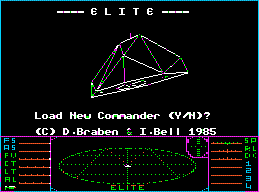Information on the only version that runs on 1970s hardware

Elite is a quintessentially 1980s game. Released in 1984 for the 1981 BBC Micro and the 1983 Acorn Electron, it was soon converted to the 1982 Commodore 64, the 1986 BBC Master and the 1986 PAL NES, as well as a whole host of non-6502 machines like the 1982 ZX Spectrum, the 1984 Amstrad CPC, the 1983 MSX, the 1985 Amiga, the 1984 Tatung Einstein, the 1981 IBM PC, the 1985 Atari ST and the 1987 Acorn Archimedes. That's an awful lot of 1980s.
So when 1986 rolled around, it was a bit of a surprise to find Elite being released for the venerable Apple II, which was launched almost a decade earlier. Even more impressive, Elite on the Apple II works on completely standard 1970s hardware; it needs a 1977 Apple II with 48K of RAM, and it needs a 1978 Disk II controller and drive... and that's it.
There aren't any extra features that take advantage of the disk, unlike the BBC Micro version, so Firebird could have released the exact same game for the unexpanded cassette-based Apple II; they presumably figured that by 1986, pretty much everybody who had an Apple was using disks, so the market was too small. But the point stands: if the disk code is removed, this version can be run on completely standard 1977 hardware, and that's fairly mind-blowing.
In terms of gameplay, Apple II Elite is still very much Elite. The graphics enjoy the endearingly weird colour-fringing of the Apple's high-resolution graphics mode but they're still at the same resolution as the Commodore 64 version, and there's a brand-new feature that makes a real difference - the ships are flicker-free, thanks to an improved ship-drawing algorithm. This improvement was carried through to the BBC Master version, also released in 1986, where it looks really special.
There are some issues, though. The trading screens use a monochrome text mode that feels like a bit of a throwback, and the Apple's keyboard doesn't support rollover, so the routines can't process simultaneous key presses. The game is definitely playable, but if you're coming from another system, the flight controls can feel a bit unresponsive as a result.
But this is Elite, a poster child of the 1980s, running on the Apple II, a poster child of the 1970s. It's amazing that it's this good, frankly, and that flicker-free fix is worth the entry price alone.
Here are some suggestions for exploring this version of Elite:
- Navigate the codebase using the map of the source code, A-Z index and source code cross-references.
- Find out how this version works under the hood with over 130 deep dive articles covering every aspect of the game.
- Download a disk image of this version from the downloads page, which you can load into an emulator or real machine.
- See the code statistics for this version.
- See exactly how this version compares to the others in the feature comparison table.
- See comprehensive details of all the different variants of this version.
- Download the source disk from Ian Bell's site as a disk image.
- Build this version from the source code with the accompanying GitHub repository.
- Visit Frontier Astro to see the box contents for this version of Elite.